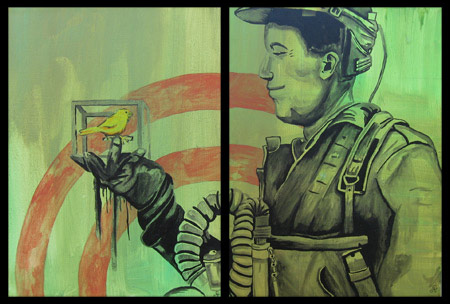Canaries, Chemists and Quantum Mechanics
 Monday, June 15, 2009 at 06:41AM
Monday, June 15, 2009 at 06:41AM I presented a short piece on ‘Einstein-a-go-go’ linking canaries (specifically those in coal mines) to some important advances in chemistry. It goes a little something like this . . .
Most people are familiar with the concept of the “canary in a coal mine”. The phrase refers to the miners’ technique of carrying a canary in a cage to warn of adverse conditions as they moved through a mine. If the canary stopped singing, fell off it’s perch, died or was generally in distress (aside from what you might expect of a small bird placed in a cage and taken underground) this was an indicator that the miners might have come across an area of changed atmospheric conditions. Other animals were also used, but canaries are particularly sensitive to some gases including carbon monoxide and methane – both of which can occur in mines - especially if there has been a fire or explosion.  Image by Alex Clauss
Image by Alex Clauss
If a change in the atmosphere in a mine was detected there were 2 main concerns: that reduced oxygen might lead to asphyxiation or that flammable gasses (such as methane) might cause an explosion, an eventuality made more likely by the use of open flames as a source of illumination. Either eventuality would spoil your day.
Even before miners starting taking canaries into mines efforts were being made to make the whole enterprise safer.
In 1815, Humphry Davy (assisted by Michael Faraday) developed a safety lamp, known as the Davy lamp. The Davy lamp is basically a candle enclosed inside a fine mesh. This mesh screen acts as a flame arrestor. Firedamp (any of the various harmful vapours produced in mines, most commonly methane) can pass through the mesh, but the holes are too fine to allow a flame to propagate through them and cause an explosion. However the flame itself can change in appearance in response to changing gas concentration, alerting the miner to possible danger.
But in 1828 Faraday developed a new version of the Davy lamp (what Bill Gates would have called version 1.2.1). Basically he’d added a movable conical chimney-pot at the top of the lamp, allowing greater control over the mixing of gas and air. Apparently this idea didn't really catch on, at least in mining settings.
Meanwhile, in laboratory settings, a number of chemists had used the idea of the Davy lamp to control the mix of gas and air and thus the specific characteristics of the flame. Previous flame sources, such as furnaces, charcoal burners, spirit lamps and coal gas all had their drawbacks, so scientists were keeping their eyes open for better alternatives. When the University of Heidelberg hired a new professor in 1852, they promised to build him new laboratories. As part of this process the new professor asked the University’s mechanic, Peter Desaga, to design a prototype flame system, based in part of Michael Farraday’s design of more than 25 years earlier.
The design that Desaga produced featured slits for air at the bottom of a cylindrical burner, with the flame igniting at the top. This generated a hot, sootless, non-luminous flame by mixing the gas with air in a controlled way before combustion. His boss, a Professor Robert Bunsen was very satisfied. By the time the building opened early in 1855, Desaga had made fifty of the burners for Bunsen's students. Bunsen published a description two years later, but neither he nor Desaga actually patented it.
Bunsen found that when he fed solutions of metals into the new flame, they emitted spectacular colours. Bunsen’s friend, Gustav Kirchoff, realised that the coloured light could be analysed using a prism. This lead to the development of spectroscopy (and spectroscopes).
Spectroscopy and research on spectral lines by scientists including Niels Bohr (who won a Nobel Prize for his work in this area) lead to greater understanding of the structure of atoms and events on a sub-atomic scale.
This in turn (eventually) led to quantum theory and quantum mechanics, but that’s another story . . .
As it happens canaries were still being used in coal mines as recently as the mid-1980s.

Reader Comments